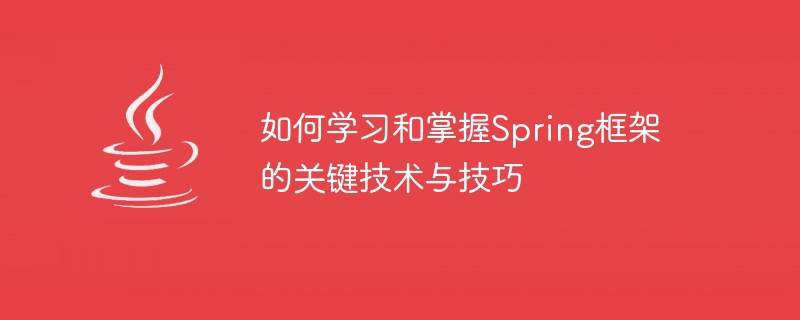Home >Java >javaTutorial >How to learn and master the key technologies and techniques of the Spring framework
How to learn and master the key technologies and techniques of the Spring framework
- WBOYWBOYWBOYWBOYWBOYWBOYWBOYWBOYWBOYWBOYWBOYWBOYWBOriginal
- 2024-01-24 08:00:081291browse

How to learn and master the key technologies and techniques of the Spring framework requires specific code examples
Introduction:
Spring framework is the most popular development framework in the Java world One, providing a wealth of technologies and tools to help developers build Java applications more efficiently. However, for beginners, the process of learning and mastering the Spring framework can feel a little confusing and complicated. This article will share some key technologies and techniques for learning and mastering the Spring framework, and provide specific code examples to help readers better understand and apply this knowledge.
1. Understand the basic principles and core concepts of the Spring framework
Before learning any development framework, it is very important to understand its basic principles and core concepts. For the Spring framework, its core principles are Inversion of Control (IoC) and Aspect-Oriented Programming (AOP). Mastering these two concepts can help developers better understand the design ideas and working modes of the Spring framework.
Inversion of control means that the process of object creation and dependency injection is managed by the Spring container. Developers only need to define objects and dependencies between objects, instead of manually creating objects and injecting dependencies. Through inversion of control, loose coupling between application components can be achieved and the maintainability and testability of the code can be improved.
Aspect-oriented programming can separate cross-cutting concerns (such as logs and transaction management) that have nothing to do with business logic from the business code and manage them in a modular manner. Through aspect-oriented programming, business logic can be made clearer and more readable, and horizontal expansion and maintenance can be facilitated.
2. Using the IoC container of the Spring framework
The IoC container of the Spring framework is the most basic and core function provided by Spring. It is responsible for managing the life cycle of objects and the dependencies between objects. For developers using the Spring framework, it is very important to be proficient in the IoC container.
The following is a simple code example that demonstrates how to use the Spring framework's IoC container to create objects and inject dependencies:
public class HelloWorld {
private String message;
public void setMessage(String message) {
this.message = message;
}
public void sayHello() {
System.out.println("Hello " + message);
}
}
public class Main {
public static void main(String[] args) {
// 创建Spring容器
ApplicationContext context = new ClassPathXmlApplicationContext("beans.xml");
// 从容器中获取HelloWorld对象
HelloWorld helloWorld = (HelloWorld) context.getBean("helloWorld");
// 调用HelloWorld对象的方法
helloWorld.sayHello();
}
}In the above code, a HelloWorld## is created #Class, which has a message attribute and a sayHello method. By defining the beans of helloWorld in the beans.xml configuration file, you can tell the Spring container how to create and manage HelloWorld objects. In the Main class, get the HelloWorld object from the container and call its sayHello method.
Dependency injection is another core feature of the Spring framework, which can help developers better manage dependencies between objects. Using dependency injection, coupling between objects can be minimized.
public class Order {
private Product product;
public Order(Product product) {
this.product = product;
}
public void printOrderInfo() {
System.out.println("Order: " + product.getName());
}
}
public class Product {
private String name;
public String getName() {
return name;
}
public void setName(String name) {
this.name = name;
}
}
public class Main {
public static void main(String[] args) {
// 创建Spring容器
ApplicationContext context = new ClassPathXmlApplicationContext("beans.xml");
// 从容器中获取Order对象
Order order = context.getBean(Order.class);
// 调用Order对象的方法
order.printOrderInfo();
}
}In the above code, an Order class and an # are created ##Product class. The Order class depends on the Product class. When creating the Order object, the Product object is injected into the Order object. middle. By defining the beans of product in the beans.xml configuration file, you can tell the Spring container how to create and manage Product objects. In the Main class, get the Order object from the container and call its printOrderInfo method. 4. Use the AOP function of the Spring framework
The following is a simple code example that demonstrates how to use the AOP functionality of the Spring framework:
public class UserService {
public void saveUser(String username) {
System.out.println("Save user: " + username);
}
}
public class LogAspect {
public void logBefore(JoinPoint joinPoint) {
System.out.println("Before method: " + joinPoint.getSignature().getName());
}
public void logAfter(JoinPoint joinPoint) {
System.out.println("After method: " + joinPoint.getSignature().getName());
}
}
<aop:aspectj-autoproxy />
<bean id="userService" class="com.example.UserService" />
<bean id="logAspect" class="com.example.LogAspect" />
<aop:config>
<aop:aspect ref="logAspect">
<aop:pointcut id="saveUserPointcut"
expression="execution(* com.example.UserService.saveUser(String))" />
<aop:before method="logBefore" pointcut-ref="saveUserPointcut" />
<aop:after method="logAfter" pointcut-ref="saveUserPointcut" />
</aop:aspect>
</aop:config>
public class Main {
public static void main(String[] args) {
// 创建Spring容器
ApplicationContext context = new ClassPathXmlApplicationContext("beans.xml");
// 从容器中获取UserService对象
UserService userService = context.getBean(UserService.class);
// 调用UserService对象的方法
userService.saveUser("Alice");
}
}In the above code, a
UserService class is created, which has A saveUser method is used to save user information. At the same time, a LogAspect class is created, which defines two notification methods logBefore and logAfter, respectively before and after the saveUser method is executed. implement. By defining the userService bean and the logAspect bean in the beans.xml configuration file, and using the <config></config> tag Configuring pointcuts and notifications can tell the Spring container how to create and manage UserService objects and LogAspect objects and the relationship between them. In the Main class, get the UserService object from the container and call its saveUser method. Summary:
The above is the detailed content of How to learn and master the key technologies and techniques of the Spring framework. For more information, please follow other related articles on the PHP Chinese website!

